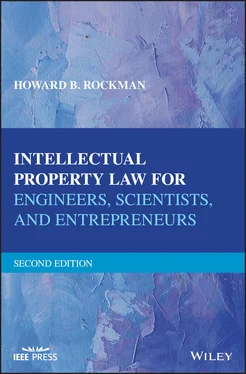It is not uncommon for several inventors, working independently of each other, to develop a same or similar invention at the same time, and for each to file for patent protection covering their invention. This is sometimes true, for example, in the pharmaceutical field, where several different companies are seeking a cure or treatment for a certain disease, and have all started with the same known “prior art” treatments. Each of these inventors or groups of inventors may arrive at the same end point independently. In this situation, who gets the patent? Under the recently enacted AIA, the patent is awarded to the first to file a patent application, unless one inventor or group of inventors derived the invention from the second to file, as discussed in section 7.2.1of this chapter.
7.2 PROPER DOCUMENTATION OF THE INVENTION
The AIA eliminated the previous interference procedure by awarding a patent to the first to file a patent application when two or more inventors or inventor groups have developed the same invention at approximately the same time. However, the AIA now includes a new section 35 U.S.C. §135, which provides a second‐to‐file inventor the ability to have the USPTO correct the inventorship in the first filed application if it can be established that the first‐to‐file inventor derived the invention from the second‐to‐file inventor. Due to the possibility that this scenario can occur, it is important for all inventors to keep adequate records, witnessed preferably, to establish the dates of conception and reduction to practice of the invention before it was “stolen.”
The act of conception relates to the first concept, idea, or informal description of a working example of the invention. Usually, the first conception of an invention takes place either on a computer screen, on small scraps of paper where the idea was initially set down, or possibly on other media of recording the inventive idea, such as a dictating machine. It is important to record the earliest date of conception because conception followed by diligence in reducing the invention to practice, in a working model or a complete illustration of a working model, would determine the date of invention that the inventor can rely upon in a derivation proceeding. My experience has shown that the initial act of conception can also be proven by presenting evidence of comments made to others in the project control group that they recall, sketches on restaurant or tavern napkins, or stained lab notebook papers.
One comment made earlier is worthy of repetition. Most inventors today work by themselves, in cells or in cubicles, in developing an invention. It is important, however, that early work on inventions be somehow witnessed by others and documented, so that, at a later time, a second party or a document can corroborate your first date of invention. Working alone on your idea without disclosing the same to other people within your working group and not having them witness and sign off on your invention is not recommended practice. Certain corporations with which I have been involved require their inventors to keep notes in lab or log books, and to have each page of the lab or log book dated and witnessed by another person in the group at the end of each day.
The reason for this exercise is that, whenever an inventor is required to testify in court or any other judicial proceeding that his or her invention has been derived by another, the inventor’s testimony must be corroborated by other documentation or the testimony of live witnesses that the inventor actually did conceive the invention at the time that he or she reported. It is obvious that anyone can sit on a witness stand and testify that they had invented a certain device before someone else, but unless they have proof of such conception, such oral evidence alone will not be accepted by the court. Therefore, keep in mind as you develop inventions throughout your careers that each step you take may have to be ultimately corroborated by someone else or by your documentation, electronic or otherwise, to prove the veracity of your statements regarding conception.
7.2.2 Reduction to Practice
The act of conception followed by diligently reducing the invention to practice are the two components that equal the act of invention, which was more important in the interference proceedings that have been eliminated by the enactment of the AIA. However, for derivation proceedings, reduction to practice may still be important. Remember, however, that the reduction to practice need not culminate in a working embodiment or model of the invention. Illustrations, drawings, screen shots, CAD files, and sketches of a workable concept also constitute a constructive and acceptable reduction to practice. Thus, you need not have a working model to file a patent application, or to prove derivation. In many instances, the filing of the patent application itself constitutes the constructive reduction to practice of the invention. Even though you do not have a working model of your invention, drawings and/or sketches that show how your invention will work and is constructed are enough to start the patenting process on its way.
The reduction to practice, however, must be of the complete invention that you ultimately are going to be claiming as the invention to be covered by your patent. The subject of claiming your invention will be covered in detail in Chapter 10. Thus, it is important to conclude from your conception, diligent efforts, and reduction to practice that the invention will work for its intended purposes, and will work the way you will ultimately describe the invention in your patent application.
Using drawings corresponding to your invention, and a written description of the structure and operation of your invention, a patent application will be prepared and filed with the U.S. Patent and Trademark Office. Therefore, it is important that, prior to meeting with a patent attorney or agent, you have a complete invention to submit for patenting, which includes the complete reduction to practice of the invention, either on paper or on a computer screen, or with the help of a working model. Again, it is not necessary or recommended to have a working model of the invention before you proceed to discuss the patenting process with your patent professional. An “actual reduction to practice” consists of the production and operation of a working model of your invention. A “constructive reduction to practice,” which is more common, consists of an expression of the invention in a written or electronic medium, such that one skilled in the art could read that expression of your invention and understand its structure and operation. Again, the constructive reduction to practice must be a description of a complete and operable invention.
In a derivation proceeding, it is important that the inventor establish the acts of conception and reduction to practice that support the patentability of the invention. Documentary pieces of paper, electronic fixations on media, and scraps of other materials are usually challenged by the defense lawyer as lacking authenticity. By having your relevant documents signed and witnessed by other parties, and dated, these other parties can then testify at trial that they signed those documents when dated, thus proving their authenticity. Also, if you tell somebody within your project control group about your invention, they can testify that they discussed the invention with you at that time. However, it is important to remember that the invention should not be discussed with anybody working outside of the project control group involved in the development and/or production of the invention. Public disclosure of the invention during its development stage and reduction to practice stage, absent a signed non‐disclosure agreement (NDA), should be avoided.
Читать дальше












